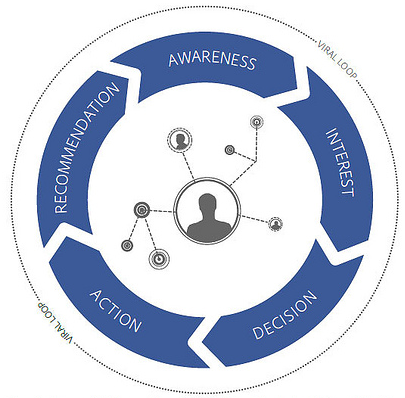Having people share your content is vital to increasing its reach and popularity because it helps introduce new people to your content. 
Like many of the things we learned in kindergarten, however, sharing is an essential skill, and one that adults often neglect. Because sharing is also central to the spread of online content like blog posts, videos, and applications, it’s important to encourage your audience to share your content.
Like many of the things we learned in kindergarten, however, sharing is an essential skill, and one that adults often neglect. Because sharing is also central to the spread of online content like blog posts, videos, and applications, it’s important to encourage your audience to share your content.
In this post, we go through nine ways to make your content more sharable, and increase its likelihood of being seen socially.
We use the term “viral” to describe content that is shared on a large scale. As we have noted before, content can spread through contacts just like a virus spreads through contact. This viral content also has the potential to reach that person’s contacts, their contacts, and so on, snowballing into something that garners wide-scale attention. While what goes viral can’t always be predicted, there are certain ways to increase your odds of getting something shared virally, which we’ll share below.
1. Make it easily sharable
One of the easiest and most effective ways to get your content to be shared virally is to have an option to share on every item that can be shared. Blog posts, pages, white papers, ebooks, videos, and any other content should be very easy to share from a user standpoint.
Make it easy to embed videos on other blogs, tweet a link, and post to Facebook, and any other social network or site. Also don’t forget to make content email friendly because, according to a recent study, email is still the way most people share content online.
2. Keep it simple
A research report from the New York Times Consumer Insight Group, “The Psychology of Sharing”, recommends keeping things simple. There’s a children’s game called “broken telephone” where one child starts off with a short phrase that is whispered from child to child, and the resulting message becomes distorted. By keeping the original message simple and straight forward, you limit the chance of it being transformed into something unrecognizable.
Some examples of content that is simple are sets of photos, lists, and short videos. It’s also best to keep content to one page, according to Hallam Communications’ Wayne Barker notes in an article. Having an article span several pages provides a bad user experience, and reduces its sharability.
3. Use implicit incentives

In her Webvisions presentation “Designing for social sharing”, designer and researcher Rashmi Sinha says to look at what your audience gets out of sharing your content. This means that your content should be useful in various ways.
She says people share content for various reasons such as:
- promoting self identity — you may post photos of your favourite band up on MySpace,
- expressing one’s self — you may post a Facebook link to a newspaper editorial along with your opinions on it, and
- promoting social status — you may tweet about the make and model of the car you just bought.
These are some of the reasons why it’s in the best interests of your audience to share your content.
4. Use explicit incentives
Some companies offer explicit incentives such as discounts and other special offers for those who spread their information on social media to someone they think would benefit from it.
According to a Microsoft-sponsored report from Columbia University researchers (PDF), “Refer-a-friend marketing” is a type of viral marketing that benefits from “the network of trust between the referrer and the potential adopters plays an important role in the adoption of a product in a viral marketing campaign.” This trust between people helps new people discover
a product, and could spark a cascade if the new adopter recommends the product to their friends as well.
5. Tag well and tag often
Tagging provides context to content. By placing content into a subject category, it is easier not only for people to find, but also for them to share with other group who have that particular interest.
For instance, you can tag photos based on the subject, where it was taken, who’s in the photo. Music videos could be tagged based on artist, style, and even mood. You can even create your own playlists that, for instance, group similar artists or one on songs that share a similar theme. Tags can help users find your content based on topics in which they’re interested, creating the common threads that lead to related information.
6. Show people other comments, poll results, and video views

- The number of views and likes are shown at the bottom of every YouTube video
Giving someone information on how others have reacted to the content can help them decide to interact and share. Developers can add widgets to webpages to allow comments, show the number of times a page has been shared on Twitter or Facebook, or show the number of times a video has been played.
This added information can help your audience contextualize the content you’ve posted, giving them some people more reason to share it. For instance, a large number of views, comments or shares could communicate the importance of the video. On the other hand, compelling content with few views, comments or shares may actually help convince someone to share because they think more people should see it.
Similarly, people will be interested in other comments and reactions to your content — even (and perhaps especially) if they disagree with other comments.
7. Manage the discussion and mediate disagreements
Even as the Internet helps promote everyone being able to express a point of view, it’s easy to see the creation of digital tribes who share similar viewpoints — sometimes resulting in one dominant view drowning out others. This is why it’s important to actively moderate discussions to create a welcoming space for alternative viewpoints.
Healthy debate is good, according to Jugnoo, Inc.’s Danny Brown, but when flooded by posts that attempt to he recommends to “ride the storm,” jumping in where necessary to correct erroneous facts and protect other readers.
Those who have a high standing within an online community are also able to sway opinion. If you created the content people are commenting on, you may be able to moderate and encourage different viewpoints and interpretations in your comments.
8. It’s not all about hits
While content based on current events, celebrities, and other popular topics can attract wide audiences, this shouldn’t necessarily be your strategy when it comes to creating your own content. It should be about creating content that it relevant to your intended audience.
As Chris Garrett notes, it’s better to figure out what group you want consuming your content most, learn about them, and create content that will appeal to them, rather than just getting more hits. Be helpful to that target audience rather than a wider audience that has less stake in your business’ success.
9. Let people combine and create

When it included a free CD of royalty-free samples in its November 2004 issue, Wired Magazine helped introduce a large audience to Creative Commons — a framework that provides different levels of permission to remix and reuse material. Wired’s CD included clips of music from the likes of the Beastie Boys, David Byrne, and Le Tigre, that anyone could use to create their own songs.
And it’s not just musicians who are letting their content be shared, repurposed, and otherwise “remixed”. An MIT research report (PDF) describes attempts to make remixing a core element of video sharing, photo sharing, audio sharing, micro-blogging, social network, and scientific data sharing websites.
The report describes remixing as “one of the most important ways in which the web is empowering the creation of knowledge and culture nowadays.” In keeping with this trend, video hosting service Vimeo, for instance, lets users share video clips, and give credit to other users for clips used in remixed videos.
While there is a danger to giving away too much content, especially if it’s central to your business model, UC Berkley law professor Robert P. Merges (PDF) says the idea of remixing has huge appeal to certain audiences: “Put simply, remix culture is fun, which means people are increasingly asking for more freedom to remix. The result, not surprisingly in a market-driven economy, is that some content producers are giving it to them.”
The power of letting go
Getting your content shared oftentimes means letting go of some control.
Media theorist Henry Jenkins writes that content becomes altered and changed when passed around. As content mutates, he says, it becomes more relevant to more people because they make it relevant to themselves and the groups to which they belong. He also theorizes that nobody — not even the content creator — has complete control over the fidelity of the message or how it’s received. “This is inevitable with any viral content,” Jenkins writes, “because messages have to reflect local circumstances and personal needs.”
This means that your message may not stay the same – but that’s not necessarily something to worry about because it’s being changed to suit other readers. Viral sharing is crucial to the spread of your content. While people who share your content get to express themselves, be sure to link your content back to your website, where they – and their friends – will be able to continue their experience with your company.
Need help setting up your online media for its best viral exposure? Kobayashi Online can help your content and your site achieve maximum impact through search engine traffic and social traffic.